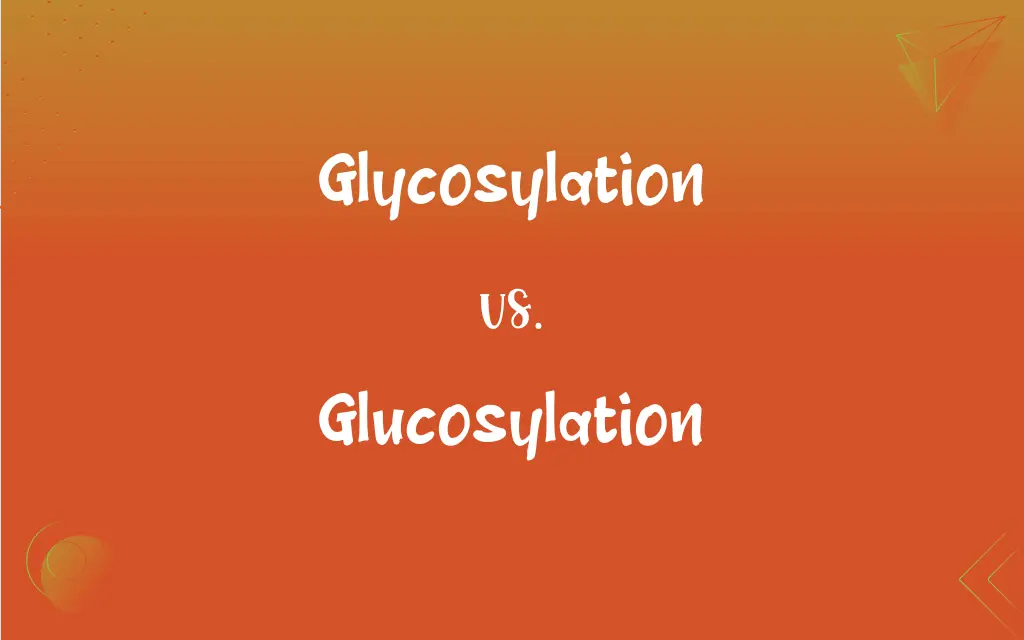Glycosylation vs. Glucosylation: What's the Difference?
By Aimie Carlson & Harlon Moss || Updated on May 21, 2024
Glycosylation involves the addition of carbohydrate groups to proteins or lipids, affecting their function and stability, while glucosylation specifically adds glucose residues to molecules, often altering their biochemical properties.

Key Differences
Glycosylation is a broad term that refers to the enzymatic process of attaching carbohydrate groups to proteins or lipids. This modification is crucial for the stability, localization, and function of these biomolecules. Glucosylation, on the other hand, is a more specific type of glycosylation where only glucose residues are added to target molecules. This process often alters the biochemical properties of the molecules, such as increasing solubility or modifying enzymatic activity.
While glycosylation encompasses various types of sugars (such as mannose, galactose, and fucose), glucosylation is limited to glucose. This specificity can lead to different biological outcomes. For instance, glycosylation can impact immune recognition, whereas glucosylation might play a role in metabolic pathways.
Glycosylation occurs in the endoplasmic reticulum and Golgi apparatus in cells, involving complex enzymatic machinery. In contrast, glucosylation typically takes place in the cytoplasm and involves specific glucosyltransferases.
Both processes are vital for cellular function but serve distinct roles. Glycosylation broadly impacts protein and lipid behavior within cellular contexts, while glucosylation fine-tunes molecular functions through the addition of glucose.
Comparison Chart
Definition
Addition of carbohydrate groups to proteins/lipids
Addition of glucose residues to molecules
ADVERTISEMENT
Types of Sugars Involved
Various (e.g., mannose, galactose)
Glucose only
Location in Cell
Endoplasmic reticulum and Golgi apparatus
Cytoplasm
Biological Impact
Affects protein folding, stability, recognition
Alters biochemical properties like solubility
Enzymes Involved
Glycosyltransferases
Glucosyltransferases
Glycosylation and Glucosylation Definitions
Glycosylation
Attachment of carbohydrates to proteins or lipids.
Glycosylation of proteins is essential for proper immune response.
ADVERTISEMENT
Glucosylation
Often occurs in the cytoplasm.
Cytoplasmic glucosylation impacts metabolic pathways.
Glycosylation
Influences protein stability and function.
Glycosylation defects can lead to various diseases.
Glucosylation
Specific type of glycosylation.
Glucosylation is distinct from other sugar modifications.
Glycosylation
Process that occurs in the endoplasmic reticulum and Golgi apparatus.
The glycosylation pathway is crucial for protein maturation.
Glucosylation
Uses glucosyltransferases.
Specific enzymes mediate glucosylation processes.
Glycosylation
A type of post-translational modification.
Many enzymes are regulated through glycosylation.
Glucosylation
Addition of glucose to molecules.
Glucosylation can modify the activity of certain enzymes.
Glycosylation
Involves multiple types of sugars.
N-linked glycosylation involves the addition of complex sugar chains.
Glucosylation
Alters biochemical properties of molecules.
Glucosylation can increase the solubility of some proteins.
Glycosylation
The addition of saccharides to proteins or lipids to form a glycoprotein or glycolipid.
Glucosylation
(organic chemistry) Any reaction that forms a glucoside
Glycosylation
(organic chemistry) The reaction of a saccharide with a hydroxy or amino functional group to form a glycoside; especially the reaction with a protein or lipid to form a glycoprotein or glycolipid.
FAQs
What enzymes are involved in glycosylation?
Glycosyltransferases are involved in glycosylation.
What is glucosylation?
Glucosylation is the specific addition of glucose residues to molecules.
What is glycosylation?
Glycosylation is the process of adding carbohydrate groups to proteins or lipids.
Where does glycosylation occur in the cell?
It occurs in the endoplasmic reticulum and Golgi apparatus.
Where does glucosylation typically occur?
Glucosylation usually occurs in the cytoplasm.
Which enzymes mediate glucosylation?
Glucosyltransferases mediate glucosylation.
Can glycosylation impact immune recognition?
Yes, glycosylation can affect how the immune system recognizes proteins.
What types of sugars are involved in glycosylation?
Various sugars, such as mannose, galactose, and fucose, are involved.
How does glucosylation modify molecules?
It can alter biochemical properties like solubility and enzymatic activity.
Can glucosylation affect enzyme activity?
Yes, it can modify enzyme activity.
What sugar is specifically added in glucosylation?
Only glucose is added in glucosylation.
Does glucosylation play a role in metabolism?
Yes, glucosylation is involved in metabolic pathways.
What is the importance of glycosylation in cellular functions?
It is crucial for protein stability, localization, and function.
How does glycosylation affect proteins?
It influences protein folding, stability, and function.
Does glucosylation involve complex sugar chains?
No, glucosylation specifically involves adding glucose.
What cellular organelles are involved in glycosylation?
The endoplasmic reticulum and Golgi apparatus are involved.
Is glucosylation considered a form of glycosylation?
Yes, glucosylation is a specific type of glycosylation.
Does glucosylation use the same machinery as glycosylation?
No, it uses specific glucosyltransferases.
Are defects in glycosylation associated with diseases?
Yes, defects can lead to various diseases.
Is glycosylation a type of post-translational modification?
Yes, it is a common post-translational modification.
About Author
Written by
Aimie CarlsonAimie Carlson, holding a master's degree in English literature, is a fervent English language enthusiast. She lends her writing talents to Difference Wiki, a prominent website that specializes in comparisons, offering readers insightful analyses that both captivate and inform.
Co-written by
Harlon MossHarlon is a seasoned quality moderator and accomplished content writer for Difference Wiki. An alumnus of the prestigious University of California, he earned his degree in Computer Science. Leveraging his academic background, Harlon brings a meticulous and informed perspective to his work, ensuring content accuracy and excellence.































































